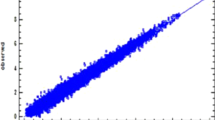Abstract
Different approaches have been used for the extrapolation of wind speed to the turbine hub height which are mainly based on logarithmic law, power law and various modifications of the two. This paper proposes two artificial neural network (ANN) hybrid system-based models using genetic algorithm and particle swarm optimization, namely GA-NN and PSO-NN for vertical extrapolation of wind speed. These models are very simple in a sense that they do not require any parametric estimation like wind shear coefficient, roughness length or atmospheric stability. Rather they use available measured wind speeds at 10, 20 and 30 m heights to estimate wind speed at higher heights up to 100 m. Proposed methods have been compared with ANN, power law and logarithmic law. Daily, monthly and yearly average values at different heights were investigated by proposed models. Predicted values at 30 and 40 m heights were compared with actual measured wind speeds. In every investigation, the mean absolute percentage error and coefficient of determination values were found to be less than 5 % and more than 0.98, respectively. Comparatively low values of mean square error of around 0.05 were also observed while comparing with other existing methods. Although GA-NN and PSO-NN have almost similar performance, GA-NN was found to be performing little better than PSO-NN.




















Similar content being viewed by others
References
The National Academies Press (2010) The power of renewable: opportunities and challenges for China and United States. http://www.nap.edu/openbook.php?record_id=12987&page=15
World Bank (1999) Meeting the challenge for rural energy and development. The World Bank http://www.worldbank.org/html/fpd/energy/e4_files/rural.pdf
IEA Wind Annual Reports (2011) http://www.ieawind.org/annual_reports_PDF/2011.html
Global Wind Energy Council (GWEC) Annual report (2015) http://www.gwec.net/wp-content/uploads/2012/06/GLOBAL_INSTALLED_WIND_POWER_CAPACITY_MW_–_Regional_Distribution.jpg
Rehman S, El-Amin IM, Ahmad F, Shaahid SM, Al-Shehri AM, Bakhashwain JM (2007) Wind power resource assessment for Rafha, Saudi Arabia. Renew Sustain Energy 11:937–950
Gualtieri G, Secci S (2011) Comparing methods to calculate atmospheric stability-dependent wind speed profiles: a case study on coastal location. Renew Energy 36(8):2189–2204
Nikola S, Zeljko D (2011) Vertical wind speed profiles estimation recognizing atmospheric stability. In: 10th International conference on environment and electrical engineering (EEEIC), IEEE
Newman Jennifer F, Klein Petra M (2014) The impacts of atmospheric stability on the accuracy of wind speed extrapolation methods. Resources 3(1):81–105
Gryning S et al (2007) On the extension of the wind profile over homogeneous terrain beyond the surface boundary layer. Bound-Layer Meteorol 124(2):251–268
Jowder Fawzi AL (2009) Wind power analysis and site matching of wind turbine generators in Kingdom of Bahrain. Appl Energy 86(4):538–545
Ulf Högström, Smedman Ann-Sofi, Bergström Hans (2006) Calculation of wind speed variation with height over the sea. Wind Eng 30(4):269–286
Rehman S, Al-Abbadi Naif M (2007) Wind shear coefficients and energy yield for Dhahran, Saudi Arabia. Renew Energy 32(5):738–749
Mohandes M, Rehman S, Rahman SM (2011) Estimation of wind speed profile using adaptive neuro-fuzzy inference system (ANFIS). Appl Energy 88(11):4024–4032
Rocha PAC et al (2012) Comparison of seven numerical methods for determining Weibull parameters for wind energy generation in the northeast region of Brazil. Appl Energy 89(1):395–400
Kaoga DK et al (2014) Comparison of five numerical methods for estimating Weibull parameters for wind energy applications in the district of Kousseri, Cameroon. Asian J Nat Appl Sci 3(1):72–87
Khan MJ, Iqbal MT (2004) Wind energy resource map of Newfoundland. Renew Energy 29(8):1211–1221
Deaves DM, Lines IG (1997) On the fitting of low mean wind speed data to the Weibull distribution. J Wind Eng Ind Aerodyn 66(3):169–178
Chang Tian Pau (2011) Estimation of wind energy potential using different probability density functions. Appl Energy 88(5):1848–1856
Chang TP (2011) Performance comparison of six numerical methods in estimating Weibull parameters for wind energy application. Appl Energy 88(1):272–282
Perrin O, Rootzén H, Taesler R (2006) A discussion of statistical methods used to estimate extreme wind speeds. Theoret Appl Climatol 85(3-4):203–215
Wan-Kai Pang, Forster JJ, Troutt MD (2001) Estimation of wind speed distribution using Markov chain Monte Carlo techniques. J Appl Meteorol 40(8):1476–1484
Li G, Jing S (2010) On comparing three artificial neural networks for wind speed forecasting. Appl Energy 87(7):2313–2320
Gudise VG, Venayagamoorthy GK (2003) Comparison of particle swarm optimization and back propagation as training algorithms for neural networks. In: Proceedings of the IEEE on Swarm intelligence symposium, SIS’03
Reza T (2013) Comparison result of inversion of gravity data of a fault by particle swarm optimization and Levenberg–Marquardt methods. Springer Plus. doi:10.1186/2193-1801-2-462
Christopher DR, Scott H, William EH, Richard KB (1997) A comparison of global and local search methods in drug docking. In ICGA, pp 221–229
Jiang L, Wu J (2013) Hybrid PSO and GA for neural network evolutionary in monthly rainfall forecasting. Intelligent information and database systems. Springer, Berlin Heidelberg, pp 79–88
Fogel David B (1994) An introduction to simulated evolutionary optimization. IEEE Trans Neural Netw 5(1):3–14
Biswas S, Mandal KK, Chakraborty N (2013) Constriction factor based particle swarm optimization for analyzing tuned reactive power dispatch. Front Energy 7(2):174–181
Marquardt Donald W (1963) An algorithm for least-squares estimation of nonlinear parameters. J Soc Ind Appl Math 11(2):431–441
Author information
Authors and Affiliations
Corresponding author
Additional information
An erratum to this article is available at http://dx.doi.org/10.1007/s00521-016-2435-0.
Rights and permissions
About this article
Cite this article
Islam, M.S., Mohandes, M. & Rehman, S. Vertical extrapolation of wind speed using artificial neural network hybrid system. Neural Comput & Applic 28, 2351–2361 (2017). https://doi.org/10.1007/s00521-016-2373-x
Received:
Accepted:
Published:
Issue Date:
DOI: https://doi.org/10.1007/s00521-016-2373-x




